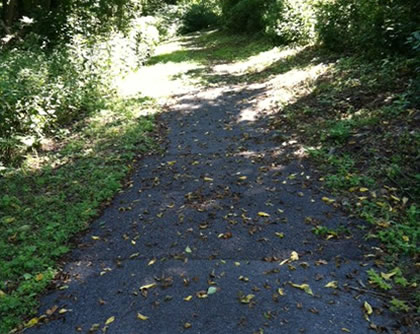
When I woke the other morning, the air felt chilly as I slipped into the space I call “my room” to do my yoga practice. And it was still cool enough when I went downstairs afterwards that Jim had cooked oatmeal for our breakfast, his “first oatmeal of the season,” as he said.
At my desk later, I found my head spinning as I looked at the well-organized sheet of notes listing all the things I should be taking care of. Fortunately, I stopped and decided the only way to gain perspective was to take a walk.
The lane where I walked divides smallish homes and the Conodoguinet creek on the left and a woodsy area below a town house development on the right. Scattered across the lane were brown leaves, and a few even floated down in front of me as I walked. Some trees sported drying leaves lacey with holes. It was quiet. No voices, no bird calls. Just the peace of the trees and a few horsetail clouds in a blue sky. I couldn’t help but think the day announced the slightest shift, an almost perceptible movement, toward the energy of fall.
I know this change toward shorter days and cooler weather is not welcome by everyone. And I’m not writing this as a foreboding of unwelcome things to come, but rather as an observation. So often our awareness of seasonal change is about what is around, outside of us. Yet the energetic qualities of each season influence all beings – including us.
In fall we observe the leaves drying and falling, often blown by the winds. The air cools. Autumn is characterized by the qualities of vata dosha, one of three constitutions described by the Indian science of health known as ayurveda. If we are in a vata stage of life – mid-50s and up – we might be even more vulnerable to these effects. We might find our hair, nails, and skin is dry. We may suffer from constipation and have trouble sleeping. We may feel ungrounded or anxious.
Knowing in advance the energetics of fall can keep us from wondering “what is the matter” if we find ourselves experiencing some of the symptoms of out-of-balance vata. Accepting that the season may exacerbate these effects, we can start making changes in our diet and lifestyles that can support a sense of balance. So, for example, if we tend to experience dryness, we can begin to add soups to our diets and take time to massage some sesame oil into our feet and joints. Our yoga practice can change to bring a sense of grounded-ness and stability to our system.
We do have to remember that how we respond to seasonal and life changes varies from person to person based upon what ayurveda identifies as our personal dosha or constitution at birth. Understanding our constitution helps us to understand our strengths and weaknesses and our responses to seasons and life events and choices. Much literature exists on the subject, and an ayurvedic practitioner can accurately identify and explain our constitution and its implications in our life.
Whether you choose to delve more deeply into learning about your constitution or not, we all can observe, without judging, the qualities of each season. We can notice how we are affected and prepare strategies to counter-balance any negative effects we may experience. In that way, we can help ourselves to “avoid future suffering“.
A very helpful perspective into looking at the change of seasons, especially for those resisting the shorter days and cooler temps.
As this is always the most difficult seasonable transition for me,
I found your blog especially helpful, Elizabeth. Thank you.
P.S. I enjoyed imagining Jim’s oatmeal awaiting you on the
perfect day.